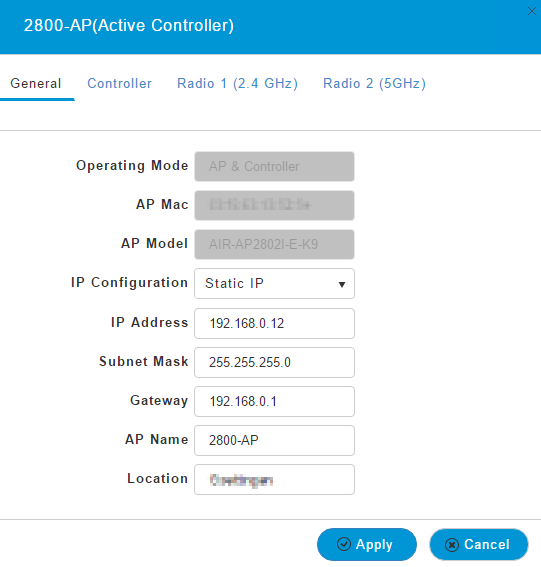First, order a new PoE+ Injector with 30 Watt output (IEEE 802.3at) -.- after some hours, not seeing the SSID, I figured out that the new 2800 and 3800 access points won’t start their radio-interfaces if the AP doesn’t get enough power. You can convert any controller-based access point to a “configurable” (formerly (autonomous) by changing the software image. You can download it at Cisco.com with your CCO ID and a registered SmartNet contract.
Start your access point and connect your serial cable to the Console port. You will see booting up a CAPWAP device. Wait long enough, the AP will start a small version of the wireless LAN controller software. After this you can configure your WLC like this:
Would you like to terminate autoinstall? [yes]: yes
Enter Administrative User Name (24 characters max): MyName
Enter Administrative Password (3 to 24 characters): *****
Re-enter Administrative Password : *****
System Name [Cisco_4d:2c:00] (31 characters max): 3800
Enter Country Code list (enter ‘help’ for a list of countries) [US]: DE
Configure a NTP server now? [YES][no]: no
Configure the system time now? [YES][no]: yes
Enter the date in MM/DD/YY format: 03/29/17
Enter the time in HH:MM:SS format: 15:19:30
Enter timezone location index (enter ‘help’ for a list of timezones): help
1. (GMT-12:00) International Date Line
2. (GMT-11:00) Samoa 3. (GMT-10:00) Hawaii
4. (GMT -9:00) Alaska 5. (GMT -8:00) Pacific Time
6. (GMT -7:00) Mountain Time 7. (GMT -6:00) Central Time
8. (GMT -5:00) Eastern Time 9. (GMT -4:00) Altantic Time
10. (GMT -3:00) Buenos Aires 11. (GMT -2:00) Mid-Atlantic
12. (GMT -1:00) Azores 13. (GMT) London, Lisbon, Dublin
14. (GMT +1:00) Amsterdam,Berlin,Rome 15. (GMT +2:00) Jerusalem
16. (GMT +3:00) Baghdad 17. (GMT +4:00) Muscat, Abu Dhabi
18. (GMT +4:30) Kabul 19. (GMT +5:00) Karachi, Tashkent
20. (GMT +5:30) Colombo, New Delhi 21. (GMT +5:45) Kathmandu
22. (GMT +6:00) Almaty, Novosibirsk 23. (GMT +6:30) Rangoon
24. (GMT +7:00) Hanoi, Bangkok 25. (GMT +8:00) HongKong, Beijing
26. (GMT +9:00) Tokyo, Osaka, Seoul 27. (GMT +9:30) Darwin
28. (GMT+10:00) Sydney, Melbourne 29. (GMT+11:00) Solomon Is.
30. (GMT+12:00) Auckland, Fiji
Enter timezone location index (enter ‘help’ for a list of timezones): 14
Management Interface IP Address: 192.168.0.3
Management Interface Netmask: 255.255.255.0
Management Interface Default Router: 192.168.0.1
Cleaning up Provisioning SSID
Create Management DHCP Scope? [yes][NO]: no
Create Employee Network? [YES][no]: yes
Employee Network Name (SSID)?: WiFiSurvey
Employee VLAN Identifier? [MGMT][1-4095]:
Employee Network Security? [PSK][enterprise]:
Employee PSK Passphrase (8-38 characters)?: *****
Re-enter Employee PSK Passphrase: *****
Create Guest Network? [yes][NO]: no
Enable RF Parameter Optimization? [YES][no]: yes
Client Density [TYPICAL][Low][High]: typical
Traffic with Voice [NO][Yes]: noConfiguration correct? If yes, system will save it and reset. [yes][NO]: yes
Cleaning up Provisioning SSIDConfiguration saved!
Resetting system with new configuration…
after the restart, login with your username and password and activate the webinterface:
(Cisco Controller) >config network webmode enable
You can now access and configure your new WLC:
you can now change your SSID or your AP name and details:
Especially for site surveys, you need to edit the tx transmit power levels. I found a bug in the web GUI, even if you change the transmit power manually, the entry shows “Automatic” but you can do it with CLI:
config 802.11a disable 3800-AP
config 802.11a txPower ap 3800-AP 4
config 802.11a enable 3800-APconfig 802.11-abgn disable 3800-AP
config 802.11-abgn txPower ap 3800-AP 3
config 802.11-abgn enable 3800-AP
you can check the power-level with the commands “show advanced 802.11-abgn summary” and show advanced 802.11-a summary”. The configured power-levels are now active:
I hope that you can save much time with this topic ;)














4 Responses
Nice to see the Mobility Express deployed. Did you make tests with 802.11r?
Hi Pat,
no currently not, I configured them for a wifi survey :) The devices also need to ping their default-gateway, otherwise they won’t start their antennas.
Ah ok ;)
Thinking about deploying a few APs with ME instead of a WLC. But I need the roaming function. Did you test, what happens, when a AP loses his connection to the master AP?
Currently not tested, I think the device will work further. Traffic will be bridged locally (they are in FlexConnect mode).